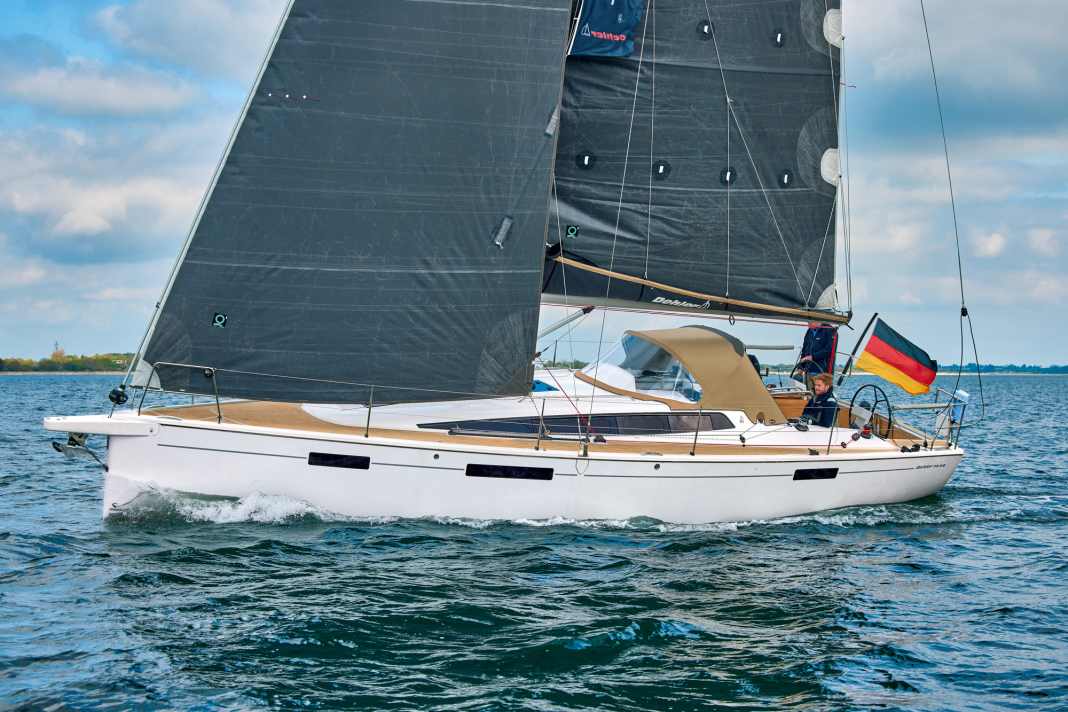





In this article:
Improve the good? Or would you rather create something new? At Dehler, they opted for the first approach: The longest-serving and best-selling model was given a promising makeover in 2021. The Dehler 38 dates back to 2013 and was the first boat to be fully developed and built in Greifswald following the takeover of the shipyard from the Sauerland region by Hanseyachts AG. "This will be a Hanse in the Dehler look!" and "How can a higher-quality boat suddenly come off the same production line?" were the rumours of the sworn Dehler community at the time. They were proved wrong, quite literally.
The Dehler 38 was an instant success. Not only did it sell magnificently, it also won prestigious jury awards. In 2014, it won the title of "European Yacht of the Year", the top trophy of all, and in the same year it was voted "Voilier de l'Année" by "Voile Magazine" in France of all places, where non-French products sometimes had a hard time gaining acceptance. In sporting terms, the boat scored respectable successes with the Dehler 38 Competition "Sporthotel" of the then project manager Karl "Kalle" Dehler. After a diversion via the motorhome industry, he had taken over his father's shipyard.
As a result, the Judel/Vrolijk design was sold around 350 times. With the Dehler 46, the 42 and the 34, the shipyard placed successful derivatives on the market. This was followed by the Dehler 30 One Design for small crews with high sporting standards and even ambitions for the new Olympic Mixed Double Offshore class. The shipyard team led by product manager for sailing yachts Andreas Unger (Kalle Dehler had since left to become an independent consultant) took a different path.
The SQ version of the Dehler 38 is better, but more labour-intensive
The almost timeless-looking hull without chines and bevelled edges and the pleasing deck shape with the elongated, wedge-shaped superstructure remained, but the boat was sporty, improved and rejuvenated for the 2021 upgrade. The shipyard has nominally labelled this with the abbreviation SQ, which stands for "Speed and Quality" - a trick that Dehler had already used in earlier times. YACHT asked to test the Dehler 38 SQ back then.
The most striking feature of the SQ is the fathead or squaretop mainsail. The large top area, made possible by a diagonal batten, provides an additional five square metres of surface area and greater aerodynamic efficiency. The downside: the wide sail at the top makes double flying backstays necessary. These are basically as complicated to operate as backstays, which were sensibly eliminated even on sporty cruising yachts in the 1980s. This is because, when tacking and gybing, the stay has to be pushed through in the new windward direction and loosened in the leeward direction, which requires more manoeuvring - and makes strong-wind gybes highly interesting manoeuvres.
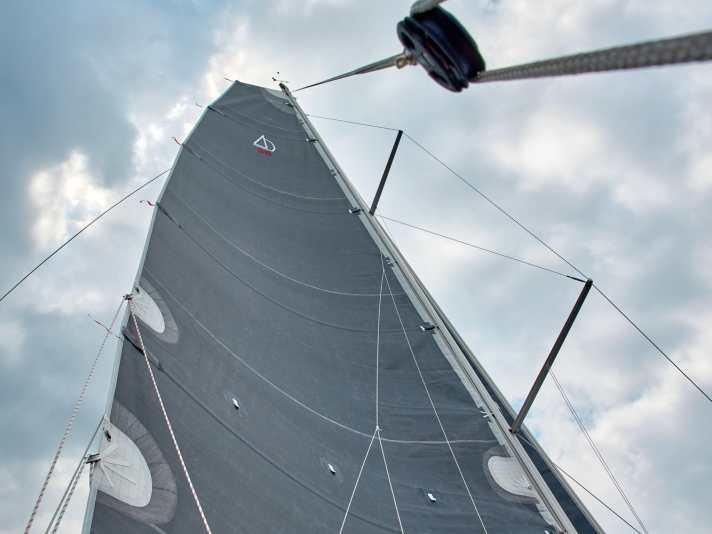
However, on the Dehler 38 SQ, the system has been successfully minimised so that the stern stays are only needed for trim, not for the functionality or stability of the rig. To achieve this, the jibs were moved 25 centimetres further aft and the spreader angle increased from 23 to 27 degrees. Andreas Unger: "The forces are distributed in such a way that the backstays really only serve as a trimming tool and the mast remains standing even without them, but you can still raise the boom far enough. That was the challenge."
However, the boat is still available with a conventional pinhead mainsail measuring 43 square metres - or with a carbon rig with a mainsail measuring 49 square metres. Around half of SQ customers to date have opted for the modern version.
28 seconds faster per nautical mile thanks to carbon rigging
According to ORC measurements, this measure provides an average speed advantage of 28 seconds per nautical mile compared to the conventional mainsail. After all. And the eye sails along, the owner can enjoy a modern look.
The aft stays of the fathead version are operated with 1:2 tackles that are attached at the very back of the deck. The forerunners are guided by lever clamps and so-called flip-flop blocks, which enable different exit angles and therefore operation on both the mainsheet and genoa winches. This works excellently, as the YACHT test with a demonstration boat from the dealer Yachtzentrum Damp showed.
There is still room for improvement only for the operating condition with gennaker, because the lever of the clamp collides with the loaded deflection block of the gennaker sheet. The shipyard is working on this. In any case, operating the backstays does not pose any major hurdles; they serve as effective trimming instruments for the mainsail and help to reduce the sag of the forestay.
The Dehler 38 SQ convinces in all respects
The boat is generally convincing, just like the conventional Dehler 38. The performance is easy to call up, the boat steers directly and pleasantly, the values are right, everything is fine. Pleasant rudder pressure is already achieved under around 10 knots of true wind, which is just right.
Apart from modifications to the backstay, there were no changes to the deck layout - and they were not necessary. The boat can be handled perfectly, even single-handed. The jib sheet is guided onto the leeward sheet winch of the German Cupper System with the mainsheet disconnected. Customers should only ensure that they order the larger optional 50 mm winches for the foresheet and 45 mm for the mainsheet. That's 2300 euros well spent for easier handling and therefore more sailing fun.
The new footrests on the bike also contribute to this. These are surfaces measuring around 70 by 40 centimetres that can be folded out of the lids of the floor boxes. The helmsman can stand on them at an angle of between 15 and 20 degrees with little fatigue, and when seated, the slopes also provide good support for the feet. Nice: In the harbour, the surfaces are flush with the deck - a perfect solution. The swim ladder, the storage space in the cockpit and the ventilation have also been improved.
Bright, friendly interior with optimised layout
The changes below deck are also striking. Larger hull windows and two additional Perspex wedges in the superstructure as well as new surfaces have made the boat much lighter in the saloon. The main bulkhead and the partition wall to the wet cell are covered with Skai material and thin upholstery with transverse seams, which is three-dimensional and pleasant to the touch and should also have a noise-insulating effect.
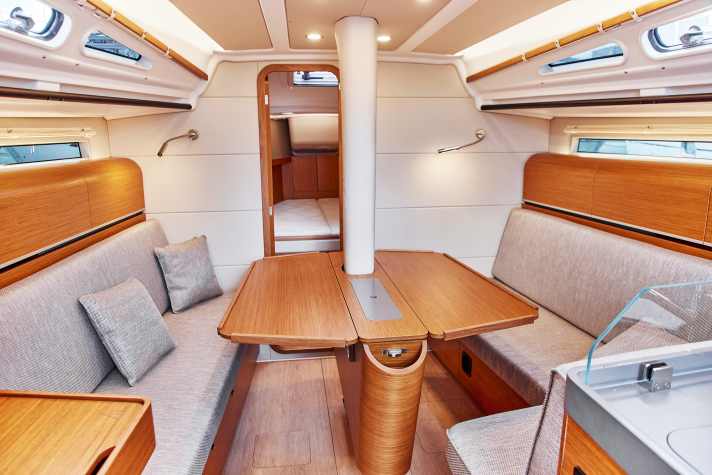
Two cabins and a large port side locker as well as no navigation table in the saloon are standard. This is available as a fixed or sliding option, which can be used to create a small dinette. Two berth variants are possible in the foredeck. The sleeping area has been moved slightly aft at the expense of two open bedside tables so that the service batteries can be placed underneath, which seemed advisable for better weight distribution. The planners replaced the lost storage space with a small cupboard at the foot end.
Dehler sticks with the tried and tested expansion
In addition to various layouts, there is a choice of three wood finishes: teak (shown in the pictures in the gallery), oak and mahogany; cherry has been removed from the programme. Acacia (as shown in the pictures), walnut and a classic striped look are available for the floor. Otherwise, Dehler stuck to the tried-and-tested design with rounded shapes and the many usable wall units as well as the spacious bathroom, which has now been copied several times, in which the door to the wet room can also separate the entire bathroom if required.
There are many arguments in favour of the boat: the very well-functioning deck layout, the excellent steering characteristics, the sailing performance, the high stability, plus the choice of rigs, mainsails and keels as well as interior layouts; this combined with great cruising boat virtues such as space, storage space, clean installations and good equipment.
The Dehler 38 SQ is unrivalled in terms of price
What's more, the customer receives this successful package at a very attractive price. Taxed ex shipyard, it is available from just under 200,000 euros, 50,000 euros below the next most expensive, directly comparable boat. Other competitors in terms of size, concept and design quickly cost over 100,000 euros more. What's more, there is only a small number of competitors. The Elan E5 is the most comparable. The J 122E is slightly shorter and more compact, while the Arcona 385 and the X 4.0 are priced in completely different spheres.
These were all reasons for the success of the Dehler 38, and they remain even more so for the Dehler 38 SQ. It impressively demonstrates how a good, proven and successful product can be improved and modernised with many small, intelligent measures.
Measured values Dehler 38 SQ
Sailing performance, without drift and current
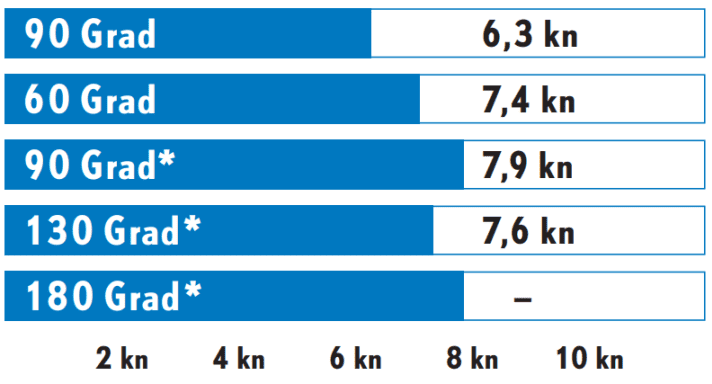
Wind speed: 7-11 kn (3-4 Bft), wave height: smooth water
* with gennaker
Potential

The value calculated with fathead size and deep keel is relatively high
1: Dimensionless number. Calculation: 2√S/3√V. The higher the value, the more sail area (S) the ship has in relation to the displacement (V).
Berth dimensions

Standing height
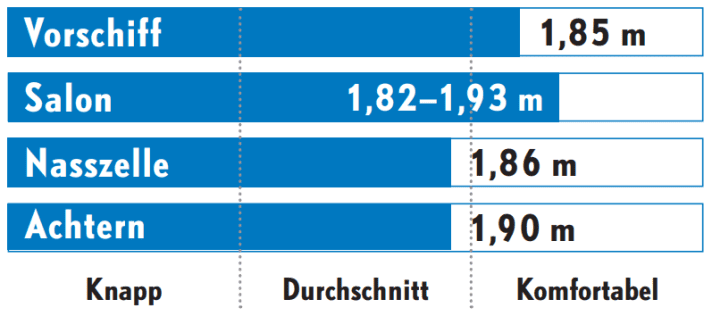
Sound pressure
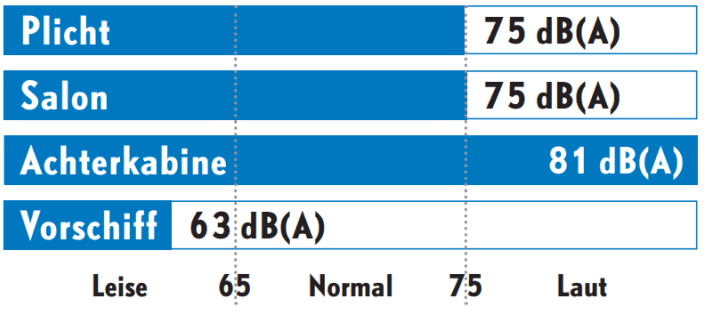
Measured at cruising speed (80 % of maximum speed): 6.3 kn, 2600 min -1
YACHT rating Dehler 38 SQ
Well-selling and successful further development of the successful Dehler 38 with sensible modifications aimed at greater efficiency, comfort and appearance. A well-sailing, easy-to-operate, well-balanced and versatile boat at a fair price.
Design and concept
- + Various power levels
- + Comparatively inexpensive package
- + vinyl ester resin/vacuum infusion
Sailing performance and trim
- + Easily retrievable good performance
- + Direct control feel
- + Rig safe despite double backstay
Living and finishing quality
- + Bright, friendly interior
- + Successful interior layout
- + Plenty of variance for layout and design
Equipment and technology
- + One-handed deck layout
- + Upscale basic equipment
- - Optional motor relatively loud
Technical data Dehler 38 SQ
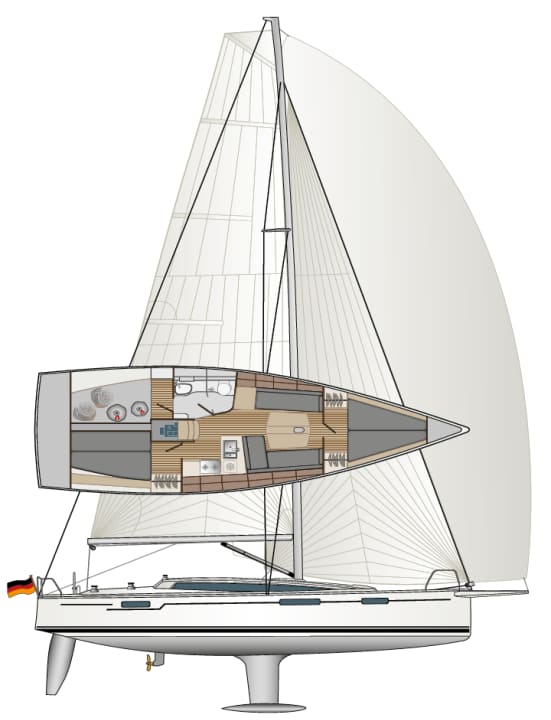
- Design engineer:Judel/Vrolijk & Co
- CE design category: A
- Torso length:11,30 m
- Waterline length:10,40 m
- Width:3,75 m
- Draught/alternative: 2,03/2,24, 1,60 m
- Theoretical torso speed: 7.84 kn
- Weight/alternative: 7,5/7,0, 7,6 t
- Ballast/alternative: 2,4/2,1, 2,8 t
- Mast height above waterline:17,70 m
- Mainsail/alternative: 43/48, 49 m2
- Furling genoa (105 %): 35,6 m2
- Rating (GPH)/alternative:630/601 sec/Nm
- machine (Yanmar):21 kW/29 hp
- Fuel tank (plastic):160 l
- Fresh water tank (plastic): 295 l
- Holding tank (plastic): 35 l
Hull and deck construction
Vacuum injection process. Sandwich laminate with balsa wood core/vinyl ester resin. Laminated bulkheads. GRP floor assembly. Deck-hull bonded
Equipment and prices
(all prices as at Q2/2021)
Base price ex shipyard 196 338 €
Standard equipment* included:
Engine, main and jib, sheets, railing, navigation lights, battery, compass, cushions, galley/cooker, bilge pump, toilet, electric cool box, waste-holding tank with suction system
- Sailing dress: 1178 €
- Anchor, chain, fender, mooring lines in the crusing package: 12245 €
- Fire extinguisher:55 €
- Antifouling: 2044 €
- Clear sailing handover: 595 €
- Price ready to sail*: 212 455 €
Also included in the price:
Folding prop, bowsprit, spring cleats, teak cockpit floor, anchor windlass, AGM batteries (160 Ah), folding footrests for the helmsman
- Guarantee/against osmosis:2 years/-
Surcharge for comfort equipment*
- Line-adjustable hole points: inclusive
- Traveller with line guide: inclusive
- Electric windlass: Included in the cruising package
- Tube kicker: inclusive
- Ation of the day:inclusive
- Jumping cleats: Included in the cruising package
- Sprayhood: 2249 €
- Teak in the cockpit: Included in the cruising package
- VHF radio, log, echo sounder, wind gauge, autopilot in the B&G navigation package: 11055 €
- Charger: inclusive
- Shore connection with RCD: inclusive
- 230 volt socket (one):inclusive
- 12-volt socket in the sat nav: inclusive
- Heating: 4225 €
- Pressurised water system: inclusive
- Hot water boiler: inclusive
- Shower WC room: inclusive
- Cockpit shower: inclusive
- Comfort price*: 229984 €
* how the prices shown are defined can be found here !
- Shipyard: Hanseyachts AG, Greifswald
- Distribution:Dealer network

